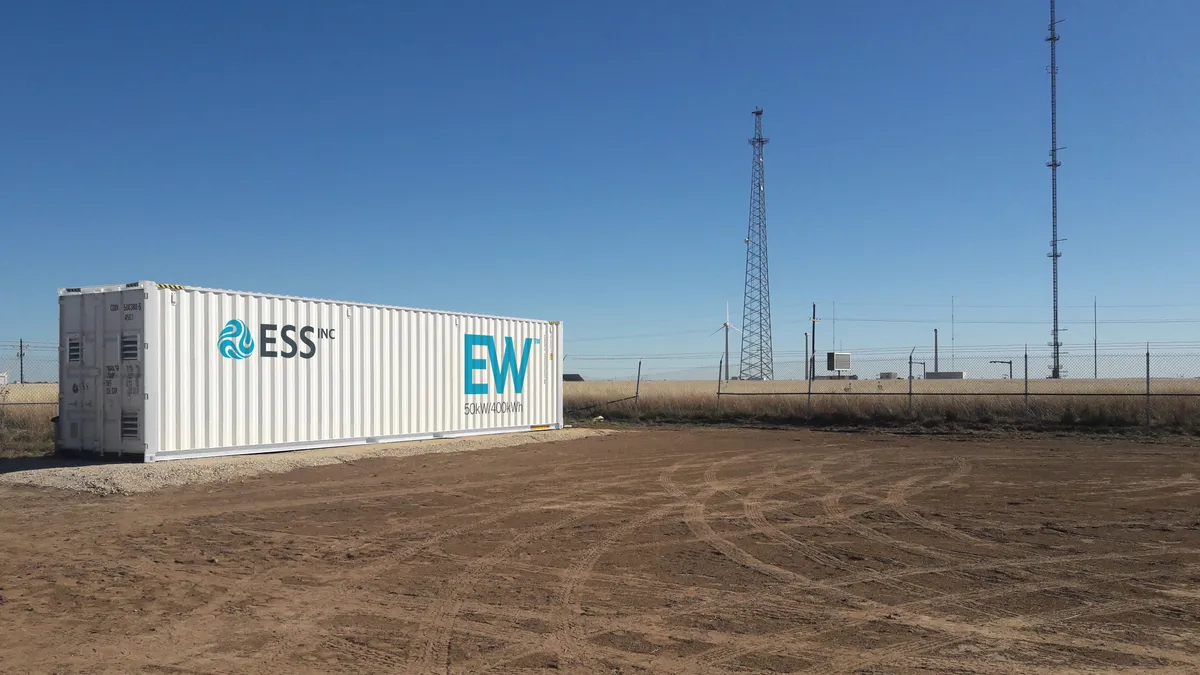Dive Brief:
- Long duration energy storage company ESS Inc. is publicly listing its stock through a merger with a special purpose acquisition company (SPAC), the latest storage startup to go public through the expedited strategy.
- Oregon-based ESS manufacturers flow batteries, which it says have advantages over lithium-ion batteries because they rely on more abundant materials and are safer from the risk of fire or explosions.
- The public listing comes amid a flurry of storage and electric vehicle startups going public through the SPAC method, a more streamlined process than a traditional initial public offering (IPO). Last month, artificial intelligence-based storage system Stem Inc. announced the completion of its business combination with SPAC Star Peak Energy Transition, becoming "the first pure-play smart energy storage company to go public in the U.S.," according to a release.
Dive Insight:
As the renewable energy sector is growing amid dropping prices and policy incentives, energy storage startups are also seeking their share of the market. In the last year, zinc battery maker Eos Energy Storage, Stem and recycler Li-Cycle have all entered the marketplace via SPAC, as have electric vehicle startups Fisker and Nikola. The results have been mixed — Stem stock, for instance, has fallen since peaking in February — but the interest shows the level of growth for the storage sector, said Sam Wilkinson, director of solar and energy storage research for IHS Markit.
The SPAC method, Wilkinson said in an email, "allows them to gain access to funds (quicker than traditional methods) that will allow them to accelerate their plans to scale up their businesses in order to validate their technologies and drive down costs. And there is urgency to do so, because the market that they intend to penetrate is growing quickly in front of them, and other technologies are racing down the cost and maturity curve."
According to a forecast from Wood Mackenzie, U.S. energy storage deployments will continue to increase over the next five years, projected to reach 7.8 gigawatts annually in 2025. That represents fivefold growth over installations in 2020.
In an interview, ESS CEO Eric Dresselhuys said the SPAC process reflected the "urgency" the company felt in the expected demand for long-duration storage, especially given the Biden administration's commitment to boosting renewable energy. The method, Desselhuys said, "lets us go faster … to build out the capacity and capitalize on the advantages of our manufacturing process," as opposed to private fundraising or an IPO.
The transaction with ACON S2 Acquisition Corp. values both companies at $1.07 billion and is projected to provide some $465 million in net cash. With the additional funding, ESS will expand manufacturing to 16 GWh across three continents.
ESS uses a unique electrolyte chemistry relying on iron, salt and water for a battery the company says is safe and does not rely on any rare earth elements. The batteries can provide four to 12 hours of energy capacity, and in February the company debuted a containerized large-scale storage solution that can be designed to meet the needs of large clients, like power providers and manufacturers installing on-site renewable energy.
"We think it's still early days for this technology," Dresselhuys said. "Everyone knows which way the grid is going, we are making sure everyone understands how our technology works and how to integrate it into long-term planning."
Ariel Cohen, a senior fellow at the Atlantic Council and director of the energy, growth and security program at the International Tax and Investment Center, said that flow battery manufacturers have potential because of the resource advantages, but still face an uncertain marketplace with larger battery manufacturers.
"Because this is a developing technology, there's a lot of corporate competition. There are a lot of winners and losers in this market, and while flow technology holds promise, it is not as dominant," Cohen said. "However, with the government so committed and jumping in with two feet into alternative energy, there can be a niche in which ESS will find its place."













